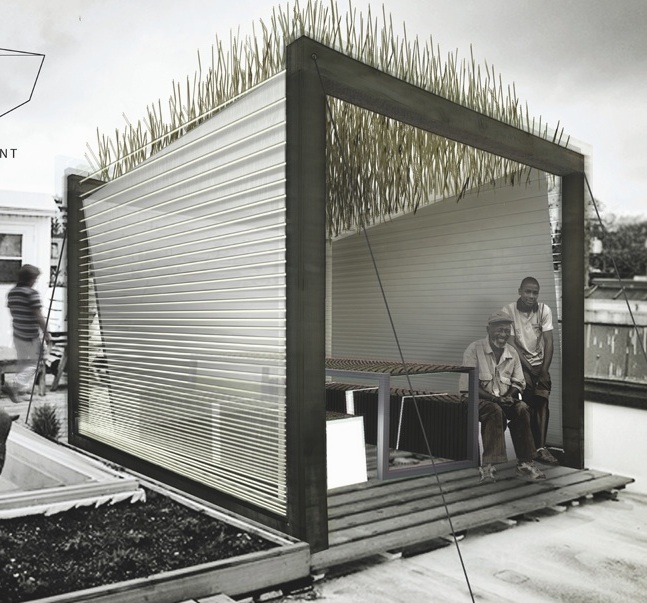By Eric Nusbaum, Assistant Editor, JTNews
By definition the sukkah is an inauspicious structure. Its origins are in the makeshift huts built by biblical Israelites for temporary shelter as they fled slavery in Egypt. The laws dictating its construction — three walls, an organic roof that leaves the visible sky— lend themselves to the ephemeral, and to the pastoral imagination.
Perhaps this is why the sukkah was such an intuitive place for Adam Newman to turn to in the months after he graduated from the University of Oregon’s School of Architecture and Allied Arts in June. Newman, a Bellevue native and Northwest Yeshiva High School graduate, sought a personal challenge and professional kick-start.
Newman and his friend Jacob Schaeperkoetter-Cochran, a production designer, had decided to try their hand at an architecture competition. After browsing blogs and architecture magazines, they came across Sukkah City, a competition in which entrants were tasked with radically re-imagining the sukkah within biblical constraints. A dozen winners would have their renderings built and displayed in Union Square Park in New York.
For Newman, Sukkah City was an immediate draw. He was well-versed in the holiday of Sukkot, but had never considered the unconventional possibilities that came with the humble dwelling associated with the holiday.
“The sukkah that I had growing up was a blue tarp and 2x4s from Home Depot,” Newman said.
However, it was not the sukkah that presented Newman’s first challenge, but the assembling of a team. In a recession economy, the prospect of devoting one’s first months after finishing school to something besides job-hunting seemed especially foolish — especially when that something is working, uncompensated, to enter a design competition with no financial reward, if indeed they were to win.
“‘You don’t have a job, you’re all moving in a couple months, you’re not going to get a full 9 to 5 now,’” Newman told his cohorts. “‘What else can you do that’s better, professionally and socially?’”
The plea worked. Logan Steinfeld, an artist, and Drew Hastings, an architect, joined Newman and Schaeperkoetter-Cochran to round out the Portland-based team. They congregated in early July for their August 1 submission deadline.
Before the brainstorming could begin, however, Steinfeld, Hastings, and Schaeperkoetter-Cochran had one more task: Since the three were not Jewish, they would need to learn a thing or two about Sukkot.
“I had no idea what a sukkah was,” said Schaeperkoetter-Cochran.
Beginning with the holiday’s back-story and extending to the biblical laws that would limit their design options, the team — including Newman — conducted a great deal of research.
“They really wanted to understand what Sukkot was all about instead of just make something that looks cool,” Newman said.
The result was a mutual sense of history and of place. The team became motivated by the universality of the sukkah concept — that the story of persecution and of survival is not just a Jewish one, and that all people could benefit from time inside a sukkah.
“I felt like I was more conscious of where I was physically, the space that I was in,” said Schaeperkoetter-Cochran. “I could relate it to what I was doing — how you had to be able to feel the rain through the roof.”
The team then went straight to work. They treated the competition as a full-time job. The foursome sat for hours at a time, making a home of Floyd’s coffee shop in Southeast Portland, consulting with a rabbi on halachic issues when needed, and powered through the days and nights fueled by caffeine and cigarettes.
Finally, just before the deadline, the team’s DialogueBox design was submitted.
The final design turned out to be a merger of narrative inspiration and practical inclination. Newman cited the dialogue between endurance and struggle and the concept of transition. The interior walls are warped and slanted to symbolize the turmoil of persecution and the exterior walls dissipate vertically to draw one’s eyes and thoughts skyward.
“We chose DialogueBox because the idea of the sukkah was to bring people together to be in this intense space with one another,” said Schaeperkoetter-Cochran.
They also chose to design their sukkah to be even more affordable and transportable than the competition regulations required. The DialogueBox design is fully collapsible and, as Newman described it, “super portable.” The project team estimates its cost at $1,500 — far less than the $10,000 budget set by competition organizers. Copyrights are pending as well.
DialogueBox was not among the dozen sukkahs selected for construction in Union Square on Sept. 19-20. But that is hardly discouraging when considering the competition. Sukkah City organizer Joshua Foer said they received more than 600 sukkah entries from 43 countries — Lebanon, Kazakhstan, Egypt, Venezuela, and Malaysia among them.
Newman said he would still like to see the sukkah constructed, preferably at a place where young Jewish people can appreciate it, such as a Hillel or Moishe House. Schaeperkoetter-Cochran on the other hand, would simply like to try his hand at sitting inside a sukkah and observing Sukkot.
“I believe it can be interpreted in a really current fashion,” he said.
